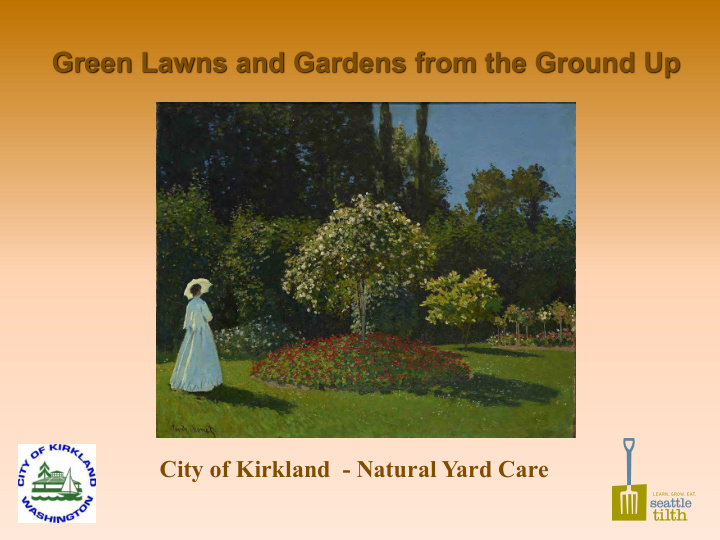



Green Lawns and Gardens from the Ground Up City of Kirkland - Natural Yard Care
The Value of Healthy Soil • Reduces need for chemical fertilizers and pesticides • Reduces irrigation needs • Filters out urban pollutants • Sequesters stormwater • Stores carbon from atmosphere S. Rose & E.T. Elliott
Soil Components Soil Components Good soil is about • “The Dirt” - half mineral (mineral particles) - half pore space (air & water) - plus a smaller but essential – sand (0.05 to 2 mm) amount of organic matter – silt (0.002 to 0.05 mm) and soil life – clay (<0.002 mm) • Air and Water (in pore spaces) • Organic Matter “Loam” is a mix of and Soil Life sand, silt, clay and organic, (create aggregates & pores) formed over time by nature
Soil Foodweb • Nematodes • Bacteria • Fungi Soil Foodweb Inc. Paul R. August, University of Minn. • Arthropods Soil Foodweb Inc. SSSA • Protozoa • Earthworms Wilhelm Foissner, University of Salzburg
Native Sub Soils in the Puget Sound Basin Land of Fire and Ice Glacial Till Hardpan Outwash Soils Lake/Marine Bed Soils Volcanic Ash Mudflows
Manufactured Soils • Inputs are sourced from variable places • Can come from construction sites • Can have certified organic components • Are not native soils • Ask for testing information
Soil Testing; A Good Tool • Determine soil health baseline • Assess nutrient quality • Get guidelines for further amendments • Assess toxin issues Toxin Concerns for Edible Gardening • Houses built pre – 1978 • Old orchard grounds • Industrial sites (old substations, auto shops) • Downwind of cement plants • Areas affected by Asarco Smelter plume • Along a busy highway
Soil Test
pH and Nutrient Availability
Amending Your Soil • Yard or food waste compost – curbside or home composting • Manure based compost – livestock and biosolids • Growing cover crops
Disturbed Soil and Compaction • Topsoil layer removed • Compaction • Subsoil (or worse) used to fill layers • Toxins
Cover Crops Protect and Nourish Soil • Protect from winter rain and leaching of nutrients • Prevent compaction • Add nitrogen • Add organic matter • Keep weeds at bay – sometimes inhibiting certain types of weeds
Mulch Protects and Nourishes Soil • Moisture conservation • Prevents weeds • Moderates soil temperature • Makes a finished look • Creates habitat for beneficial insects and birds
Growing a Healthy Sustainable Lawn • Mowing height – 2 inches minimum to outcompete weeds, shade soil, conserve moisture • Grasscycle – reduces need for fertilization to one application in the fall • Use natural, organic lawn fertilizer instead of chemical fertilizers • No Phosphorus is allowed in lawn fertilizers unless your soil test shows P depletion – protects waterways
Growing a Healthy Sustainable Lawn • Apply lime in the fall if pH is low – check your soil test • Lawns need 6-8 hours of sun – if too shady try alternatives • Provide adequate water – 1 inch per week to 6 inch depth • Good drainage matters–aerate and de- thatch and spread compost and reseed to keep them invigorated
Lawns are… • Many individual plants • Grasses that like to grow tall • Good competitors when healthy • Permeable when healthy • Hungry! • Thirsty!
Lawn and Seed Choices for NW Gardens • Perennial Rye • Perennial Fescue • Kentucky Bluegrass Perennial Rye • Eco-Turf • Native Grasses • Steppable Groundcovers Steppables – Creeping Thyme • Perennial Clover Perennial Fescue White Clover Eco-Turf
Lawns in the Wrong Place • Slopes - No more than 12% grade – avoid runoff, hard to mow – use groundcovers instead • Ponding – Indicates compaction or high water table – assess for and correct or plant adapted plantings • Under Conifers – Shade, tree roots, needles, ground water – substitute with shade loving perennials, ferns or groundcovers. • Shady Garden – Lawns need 6 – 8 hours of sun daily Substitute with shade loving plants and natives.
Weeds and Lawns Weeds will outcompete lawn if conditions for healthy lawns are not met. Improve the health of your lawn to overcome weeds. Corrective measures include: • Mowing high – 2 inches to shade out weed seedlings • Not letting weeds go to seed • Aerating, de-thatching and topdressing -improve soil conditions • Removing lawn from areas where it cannot thrive • Tolerating some weeds – clover adds nitrogen to the soil
Common Lawn Weeds Buttercup Dandelion Plantain Moss Cat’s Ear Clover Sheep Sorrel Self Heal Some weeds are edible, others improve soil, many are companionable with lawns
Common Lawn Weeds Daisy Yarrow Ground Ivy Annual Bluegrass Speedwell Tall Fescue
Common Lawn Pests • Moles Tunneling and hills – indicates your soil has life in it! Stamp down hills and runs, tolerate until they go deeper into ground in summer • Crane Fly Creates bare patches in the soil Indicates moist soil – correct or adapt, let lawn go golden in the summer, attract birds as predators, chickens and larvae, reduce pesticide use, apply nematodes as a bio-control • Red Thread Cosmetic damage mostly – indicates low nitrogen and wet soil Mow off infected blades and fertilize Prevent by keeping soil fertile and well drained
Common Lawn Pests Mole hills Crane Fly Damage Red Thread in Active Stage
More Resources • Garden Hotline – 206-633-0224 – www,gardenhotline.org • Seattle Tilth classes www.seattletilth.org • “Teaming With Microbes” Jeff Lowenfels and Wayne Lewis Please join us next for : Planting a Water Smart Garden – May 21 Pollinator Savvy Plant Care - June 4 Grand Raffle Prize is a garden consultation with ~Lisa Taylor~
Recommend
More recommend